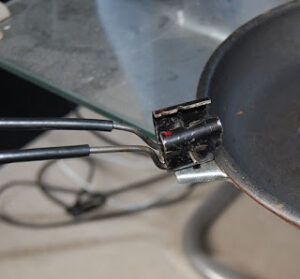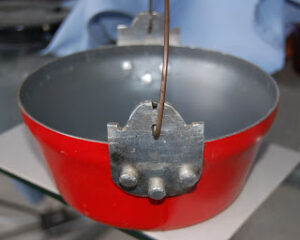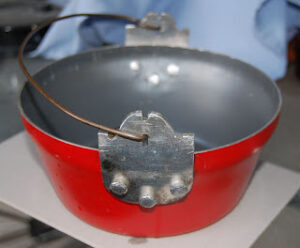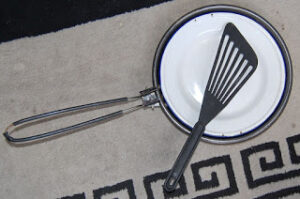As has become the tradition this week, today’s blog will start with a quote from Kephart:
“Cooking Kit.—It is easy to make up a good lightweight set of utensils for two or more men (see Vol. I. pp. 1 18-123), but a satisfactory one-man kit is another matter. The Boy Scout sets do fairly well for a short outing when baked bread is carried, but are inadequate for baking on the journey. A reflector is too cumbersome for a lone woods-cruiser. Let him bake his bread and cakes in a frying-pan (see Vol. I, pp. 344-345). This, calls for an 8 or 9-inch pan. Get one with folding handle (detachable ones are easily lost), or take a common one, cut off all of the handle but about 1½ inches, and rivet on this stub a semi-circular socket into which you fit your stick for a handle when you go to cooking. For general use I do not like aluminum frying pans, but when traveling afoot they are satisfactory. A deep aluminum plate fits inside the pan in my kit, along with an aluminum fork, whitemetal dessert spoon, and a dish towel. When tied up tightly in a light bag they do not rattle around.
You want two little kettles for cereals, dried fruit, tea or coffee, to mix dough in, and the like. A pot that is broad and shallow boils water much sooner than one that is deep and narrow, and it is easier to clean. The kettles must not be too big to stow in the knapsack. Anyway, when one is going afoot he does not want to bother with food that takes long boiling, and so has no use for a large kettle, 1 choose two 1-quart aluminum buckets, which can be bought through any dealer in kitchen ware, fill them with part of my foodstuffs, set them bottom to bottom, and tie them tightly in a bag so that the covers will not come off. So there is no waste space, for the food must go somewhere, anyway. The kettles are good protection for perishables. Thus no sooty vessel goes inside another, and you have a package of small diameter.
A seamless tin cup is carried wherever convenient, generally outside the pack, where it can be got at when one is thirsty. Aluminum is much too hot for cup and spoon. The complete kit weighs just 2 lbs, 2 oz. including bags. No table knife is carried, as I wear a sheath knife.”
Camping and Woodcraft. Horace Kephart 1921 (Vol.2 p102)

Elsewhere Kephart shows a frying pan with a folding handle with rings through which a stick extension can be inserted. The same feature was seen on the Swedish mess kit described a few days ago.
specifications are very logical, and based on decades of experience and experimentation. Producing a similar kit for my own use proved to be more problematic than one might expected!
Billies are the main problem. Most items now sold by suppliers as “Billies” are nothing of the sort. They are saucepans with side handles. A true billy has a pail or bail handle like a bucket. This lets it be hung above a fire and then raised higher when you want the contents to simmer. You can use it as a bucket to carry water from a water source. It carries much more easily than a saucepan. You can even swing a billy back and forth by its handle, build up speed and then take it around in a full circle. This is the traditional Australian outback way to settle coffee grounds or tea leaves. You centrifuge them down!
You can buy true billies as cooking vessels but the majority on offer are far too big. They are for feeding hungry scout troops, not solitary travellers.
Suitable frying pans often have the opposite problem. They are often too small. Some are designed to serve as lids for pots, but obviously they can only do one job at a time. Many have detachable handles, or to be more realistic, “losable” handles.
So, twenty or more years ago the younger me put down his treasured and much read copy of “Camping and Woodcraft” and attempted to solve the conundrum of the camping cooking kit. 

The frying pan was the easier problem to solve. I brought a lightweight frying pan from a local budget store. I cut off the handle, leaving a short stub. To this I attached a piece of aluminium bent into a not quite complete square section piece of tube. Attachment was by cold riveting with aluminium rivets (the only time since school I have used a technique learnt in metalwork class!) Holes were drilled in the sides of the fitting for the attachment of a wire handle. The handle folds by squeezing it slightly to pass through the channel in the top of the handle fitting. It can also be removed if desired. The square section tube also acts as a socket for the insertion of a suitable stick to act as a longer handle if needed.
To create the billies I brought two “milk pans” from a budget store. The handles were sawn off and the rivets where they had been attached were drilled out. Using these holes I attached a piece of aluminium plate, cut and filed to shape. Opposite this plate more holes were drilled and a similar plate fitted. These are the “bail ears”. I think these look rather crude but an engineer friend of mine was quite impressed by them. I used my cold riveting skills to attach these but pop-rivets would probably work just as well. Pop-rivets are sometimes hollow but this will allow a little bit of steam to escape when the lid is on, so this should not be a problem. 


Word of warning here. Aluminium is a very reactive metal so don’t, for example, use copper rivets with aluminium plate. They will react together and corrode. Read up on this topic and when in doubt ensure you use “like with like”.
Using aluminium rod a bail handle was made and fitted to the bail ears. Note how the handle and bail ears are shaped so that the handle locks in an upright position when desired. This was the suggestion of the friend I was scrounging the plate and rod from and is rather neat!

A good camping billy needs a lid. The lids for mine were made from the bottoms of catering-size food tins. Yes, I had mates in the kitchens as well as the workshops! You will come across articles where cooking vessels are entirely made from tin cans. This is not actually recommended since modern tins tend to have a plastic coating inside. This is not designed for prolonged use as a cooking vessel. The tins I used are only used as lids, so don’t get the heat a cooking vessel does. As you can see, each lid has a tab with a folding ring riveted in its centre. I can use this to lift the lid with a stick or similar implement.
Since they have tapered sides the two billies can be nested even though they have the same capacity. In practice, I do as Kephart suggests: I fill them with foods, put the lids on and place them in a bag, base to base. 
The final part of the kit is the plate. I wanted the plate to also serve as a cover for the frying pan when needed, which eliminated plastics. The plate is an enamelled tin plate. Using a ceramic cutting bit and a fine drill bit I drilled small paired holes in the rim of the plate and used paperclips to create two loops that could be used to lift the plate when it is used as a cover. When travelling the plate fits inside the frying pan and both are carried in a stuff sac I had that was just the right size. This may be accompanied by a spatula, nylon, pan scourer, plastic spork and plastic tubes of washing up liquid and cooking oil. I had planned to add a lightweight plastic cutting board to fit over the plate but never got around to it.

I used this simple but versatile cooking kit when I hiked in Iceland. Some of my travelling companions regarded it as unusual, but unarguably effective. I was obviously eating better meals than them while carrying less weight.
Having cooked with a few alternate cooking kits over the years I find my homemade kit still holds its own. While it is quite light for a kitchen item the frying pan is a much heavier duty item than is found in many camping kits. It has the advantage of a cheap non-stick coating too. The milk pans also had a non-stick coating which is still in a very nice state, even though I scratched some measuring marks into it.
It has been a while since I have had a chance to use these, so they do look a little dusty in the photos. My modifications were never going to win any beauty contests but they have certainly proved themselves up to the tasks asked of them!









